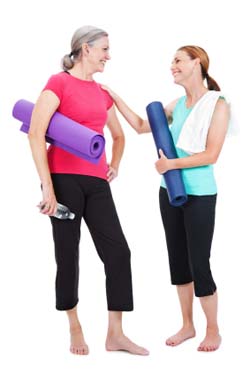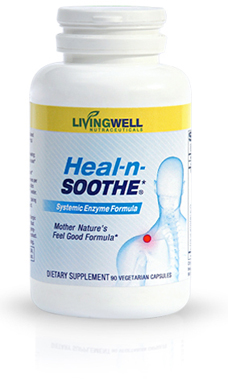
Recover from your workout fast and avoid sore muscles
Working out doesn’t have to mean pain and aching muscles.
That’s the stereotypical experience. You hit the gym hard and you hurt for days. As soon as you feel better, you repeat the process. But that’s not a good way to stay in shape.
In fact, that on-and-off cycle of a heavy workout followed by days of rest followed by another heavy workout is the perfect recipe for exercise-related injuries. And once you’re injured, your injury can stick with you for weeks … months … or even years.
It’s time to skip out on this cycle completely by using good workout recovery techniques. These help your body bounce back from each workout strong, healthy, and ready for the next trip to the gym.
In fact, with the right workout recovery techniques, you can actually heal and repair your body after each workout faster than ever.
Workout Recovery Tip #4: Cool Down
When you get to the end of your workout, do you cool down or just stop?
If you’re just stopping — throwing down that weight, jumping off the treadmill — chances are you get hit with delayed muscle onset soreness (DOMS). This is that next day soreness that keeps you from getting back in the gym along with tightness that inhibits your range of motion.
Fancy name aside, DOMS is a serious problem for exercisers. If you can’t breathe properly because your abs hurt and can’t walk right because your legs ache, you’re opening the door for muscle injuries and making any existing muscle problems worse.
Ultimately, DOMS is caused by an acid-oxygen imbalance in your muscles. All the small tears in your muscles caused by a good workout are designed to be covered in fibrin, the body’s natural enzymatic response system.
Fibrin creates a protective web over muscles, allowing them to heal and protecting against inflammation. Yet after age 27, your body’s natural production of proteolytic enzymes diminishes rapidly.
Without enough proteolytic enzymes to quickly clear away excess fibrin, the excess fibrin accumulates around these little muscle tears. The fibrin impedes the flow of blood which brings crucial oxygen to the area and removes built up lactic acid.
Overwhelmed by lactic acids and seriously deficient in oxygen, these muscle tears are slow to heal, leaving you stiff and sore the next day.
An effective cool down — 5 to 10 minutes of low intensity exercise at the end of your workout — fights DOMS.
The cool down period in particular allows your heart and breathing to return to resting levels gradually, helps your blood remove excess acids, and encourages a proper fibrin-enzyme response to muscle tears. Even if it means you need to cut your workout a little short, a good cool down is an essential piece of smart workout recovery.
Workout Recovery Tip #3: Stretch
Stretching helps pull out knots in your muscles and expands your range of motion. Yet busy schedules often keep you from making this a part of your workout recovery. Do yourself a favor — make time!
After a workout and cool down session, your muscles are warm and loose. There’s no better moment to work on your range of motion, especially in areas where you have scar tissue or inflammation from past injuries. You want to pull on the built up fibrin web, lengthening it and allowing the fibrin-chasing proteolytic enzymes to go to work eating away any excess fibrin that may be limiting your overall flexibility and creating painful muscle imbalances.
If it sounds a little strange, remember this is the exact same purpose of pressure point massage therapy — to dig into knots of tension and the tightness around scar tissue to loosen things up for the body to heal itself with a proteolytic enzyme response. You could pay $100 or more for a session with a therapist … or you can incorporate stretching into your workout recovery and make the most of your body’s natural healing process.
Workout Recovery Tip #2: Hydrate
After a workout, you need to rehydrate. Fluids help your body recover from sweat loss and sweep toxins out of the bloodstream. This cuts inflammation and reduces muscle pain.
Unfortunately, many people reach for a sports drink after they exercise. Big mistake! Most commercial sports drinks are packed with extra sugars. Sugar — which means fructose, sucralose, or sugar alcohols — contributes to post-workout inflammation by boosting your uric acid levels. It disrupts nutrient processing and feeds chronic pain.
Why deal with that? Save your money AND save your body by reaching for regular H2O after your workout. It may not be glamorous, but it’s what your body needs to recover faster and better before your next session at the gym.
Workout Recovery Tip #1: Take Heal-n-Soothe®
As the last step in your workout recovery system, you’ll want to reach for Heal-n-Soothe®, an all-natural inflammation fighter that promotes healthy muscle repair.
Heal-n-Soothe’s secret weapon for your recovery is its concentrated dose of proteolytic enzymes. These enzymes eat excess fibrin and scar tissue for lunch, helping every little muscle tear heal properly to deliver a full range of motion while reducing inflammation, tightness, and pain. They work at a cellular level, ensuring your workout recovery starts from the ground up.
Made with 12 of nature’s best anti-inflammatory compounds — including pineapple bromelain, tumeric, ginger extract, and Mojave Yucca — Heal-n-Soothe® replenishes your body with the proteolytic enzymes it no longer makes enough of on its own. Papain, Protease AM, Protease 6.0, and Alkaline Protease all work together to make your cool down more effective, give a boost to your stretches, and help your hydration go all the way to your core.
Why get stuck in a bad workout cycle of overuse, injury, and disuse? You can do better. Include Heal-n-Soothe® in your workout recovery system to feel better right after you hit the gym … and still feel good the next day, too.

Get the ONLY Proteolytic Enzyme Supplement with
12 of Nature’s Best Natural Anti-Inflammatories
References
Mercola, J. This addictive commonly used food feeds cancer cells, triggers weight gain, and promotes premature aging. Mercola.com. 2010 April 20.
Roth, Stephen. Why does lactic acid build up in muscles? And why does it cause soreness? Scientific America. 2006 Jan 23.
Warming up and cooling down for exercise. MIMS Australia.


Thank you. I’m mostly interested in recovering after a hard day’s work. Or several. One job was 10 hours/day, 7 days a week and I kind of had to take a day off every week or so. Your advice should help. Doing a similar article about recovering from work may help a lot of people.
Is it lactic acid that causes DOMS? I’ve read that lactic acid stimulates human growth hormone, unless you’ve had carbs within the previous few hours. Some lactic acid workouts I saw used less than max weights, so there probably wasn’t much muscle tearing.
Chuck,
There is a distinct difference between what happens at work and what happens after a workout…
Working 10 hours a day, 7 days a week is most likely an adrenal issue, and while exercise can help you restore balance to your adrenals, it is something that, you and a good MD or ND can work to balance out in other ways. Please be sure to search our site as we have lots of article on Stress and Adrenal issues.
No Lactic acid is not the cause of DOMS, and no you do not need to workout with max weights to produce lactic acid or generate micro tears.
Lactic acid is the bodies protective mechanism, so that you do not workout to hard to fast and do something your body is not trained for, example, If you are untrained and you tried to run as fast as you can, you maybe able to run 100yrd, and have very little LA and almost no DOMS, but if you tried to run that same speed 400yrds, that is a different story, you will build up LA that will slow you down or stop you sometime before the 400yrds mark. and you will have both LA built up and most likely DOMS, but having that LA build up is the protection from a complete ligament tear vs DOMS, the great thing about the human body is that we can train our selfs to delay LA build up and we can use DOMS to our advantage in our workout and human performance.
As a test, try doing 100 hindu squats (as they are body wt only not high wt or max wt.) and see what happens
the next day…
Steve